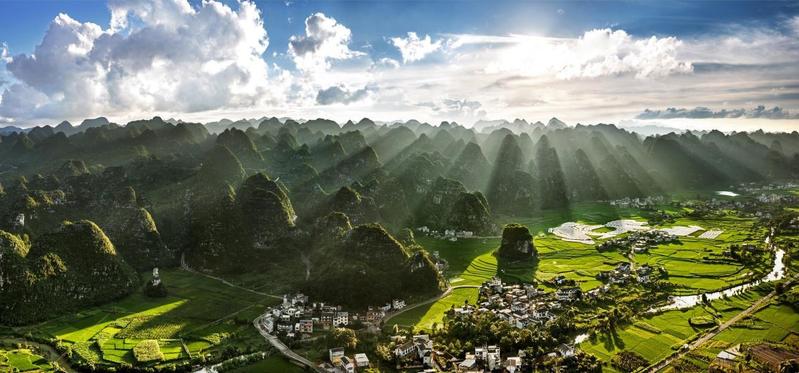An array of outdoor activities may help restore tourism to pre-pandemic levels, report Yang Feiyue in Beijing and Yang Jun in Guiyang.
 Wanfenglin scenic area in southwestern Guizhou's Xingyi features forested mountains. (PHOTO PROVIDED TO CHINA DAILY)
Wanfenglin scenic area in southwestern Guizhou's Xingyi features forested mountains. (PHOTO PROVIDED TO CHINA DAILY)
Guizhou province will tap its pleasant climate, hot springs and natural medicines to become a top international mountain-tourism destination loaded with summer resorts and forest getaways, according to Zhang Yuguang, head of the provincial culture and tourism department.
It will take advantage of its stunning geography, including deep valleys, lakes and precipitous mountains, to accelerate the development of adventure rafting, rock climbing, recreational aircraft, skiing and mountain sports, Zhang says.
"Guizhou will continue to expand the supply of high-end and diverse tourism choices through enrichment and upgrades," he says, adding that Guizhou will also focus on gear for mountain tourism.
The province won an award for sustainable mountain tourism at the annual conference of the International Mountain Tourism Alliance, which was held in Guiyang, the provincial capital, in mid-November. More than 300 representatives from 17 countries and regions, including Nepal, Indonesia, Japan, Germany, Russia, Italy and New Zealand, joined the meeting, which aimed to explore ways to restore the tourism market to pre-pandemic levels.
Globally, tourist numbers dropped 70 percent from January to August year-on-year, with US$730 billion in losses to the industry, says Zhu Shanzhong, a senior official with the United Nations World Tourism Organization.
The organization expects the tourist count to plummet by 850 million to 1.1 billion in 2020, with losses of US$910 billion to US$1.2 trillion.
At the mountain-tourism conference, the World Travel and Tourism Council, Pacific Asia Travel Association, World Tourism Cities Federation, World Tourism Alliance, ASEAN-China Center, World Historic and Cultural Canal Cities Cooperation Organization and the China Association of National Parks and Scenic Sites have signed strategic cooperation agreements or memorandums of understanding to boost the recovery and development of global tourism, especially mountain tourism.
Guizhou has surveyed its mountain-tourism resources, strengthened mountain-tourism infrastructure and enriched related experiences over the years, says Zhang, the Guizhou tourism official.
The efforts helped bring 86 million tourists to the province in October, about 10 percent fewer than the same period last year. Tourism income for the month reached 83.1 billion yuan (US$12.7 billion),80.5 percent of last year's.
Travelers can take in stunning valley views and go spelunking in Shuanghe Cave in northern Guizhou's Zunyi city. The cave, a karst formation that was discovered in the late 1980s, is 250 kilometers long-the longest of its kind in Asia and the fifth longest in the world.
Guizhou Shierbeihou Tourism Development Co has been working to transform an area of 600 square km that covers Shuanghe Cave into a mountain-tourism hot spot.
In addition to the cave, the area comprises a mix of valleys, lakes, forests and prairies.
"It has everything, except for ocean and desert," says Chen Jin, chairman of the tourism-development company.
In southwestern Guizhou's Xingyi, efforts are underway to develop mountain tourism and outdoor sports. Pedestrian paths have been set up in major mountain resorts, including Wanfenglin scenic spot. Mountain biking, water sports and camping facilities are up and running.
"We have integrated folk culture into the scenic spots," says Ran Xingpu, a manager with Wanfenglin Tourism Group.
A large stage show featuring local ethnic Buyi elements, such as the dancing lion and drum dance, as well as mountain and water sacrificial ceremonies, are offered to diversify mountain travelers' experiences.
International hiking, cross-country races and lake fishing are also available, along with night markets and light shows.
The company now operates seven scenic spots in Xingyi. It received 1.56 million tourists in 2019, up nearly 3 percent over the previous year. Tourism income grew 5.75 percent year-on-year to 126.5 million yuan last year, according to Ran.
Xingyi will develop rock climbing, ziplines, gliding, cross-country races and extreme sports to make maximum use of local mountain-tourism resources, local authorities say.
Speaking of future development, Zhang says hiking, sightseeing gondolas, first-aid stations and toilets will be upgraded at mountain-tourism destinations across the province.
Big data will also be used by scenic spots, travel agencies and homestays to make things easier for travelers and boost the recovery of tourism, he says.
Zhao Yandi in Guiyang contributed to the story.
Contact the writers through yangfeiyue@chinadaily.com.cn


